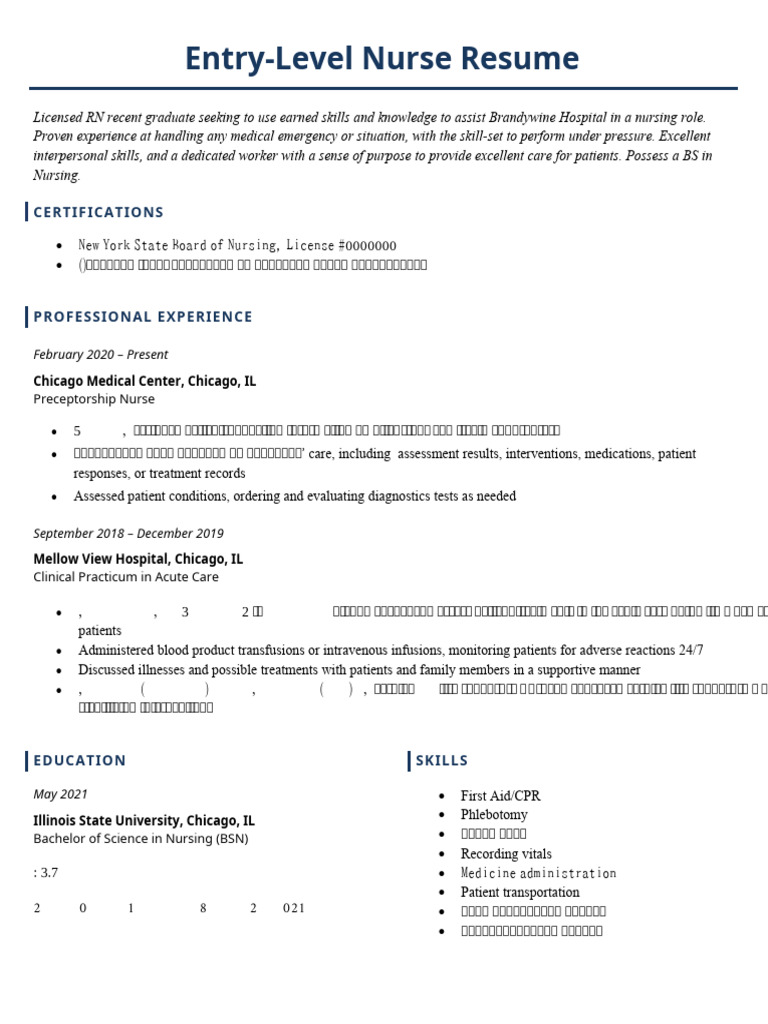The Ultimate Nursing Resume Guide

Crafting an exceptional nursing resume is a vital step for anyone pursuing a career in healthcare. With a well-structured and tailored resume, nursing professionals can showcase their skills, experience, and qualifications, ultimately increasing their chances of landing their dream job. In this comprehensive guide, we will delve into the intricacies of creating a nursing resume that stands out, covering everything from the basics to advanced strategies. By the end of this article, you'll possess the knowledge and tools to craft a resume that leaves a lasting impression on potential employers.
The Anatomy of a Successful Nursing Resume

A nursing resume serves as a concise representation of your professional journey, highlighting your expertise and potential value to a healthcare organization. Here’s a breakdown of its key components:
Personal Information
Start by including your full name, contact details (phone number and email address), and a professional profile summary. The summary should be a brief, attention-grabbing statement that emphasizes your key strengths and areas of expertise.
Education and Certifications
Detail your academic background, including the name of your nursing program, the degree earned, and the graduation date. Also, list any relevant certifications or licenses, such as Basic Life Support (BLS) or Advanced Cardiac Life Support (ACLS) certifications. Ensure you mention the date of certification and its validity period.
| Certification | Date of Certification |
|---|---|
| Basic Life Support (BLS) | 03/2022 - 03/2024 |
| Advanced Cardiac Life Support (ACLS) | 05/2021 - 05/2023 |

Professional Experience
Chronologically list your work experience, starting with your most recent position. For each role, include the job title, employment dates, and a concise description of your responsibilities and achievements. Quantify your accomplishments whenever possible. For instance, “Reduced patient fall rates by 20% through proactive fall prevention strategies.”
Skills and Abilities
Showcase your technical skills, such as proficiency in electronic health records (EHR) systems, as well as your soft skills, like effective communication and teamwork. Consider adding any language skills that might be relevant to your nursing practice.
Additional Sections
You can also include optional sections like Awards and Honors, Publications, or Professional Memberships to further highlight your accomplishments and involvement in the nursing community.
Formatting and Layout

A well-formatted resume is crucial for readability and ease of navigation. Here are some formatting tips:
- Use a clean, professional font like Arial, Calibri, or Times New Roman.
- Maintain a consistent font size and style throughout the resume.
- Utilize bullet points to make your resume scannable and easy to read.
- Limit your resume to one or two pages, focusing on the most relevant information.
- Avoid clutter by using ample white space and appropriate margins.
Tailoring Your Resume for Nursing Roles
One of the most critical aspects of resume writing is tailoring it to the specific nursing role you’re applying for. Here’s how to achieve this effectively:
Understand the Job Description
Carefully read the job posting and identify the key requirements and responsibilities. Highlight the skills and qualifications that align with the job’s needs.
Use Relevant Keywords
Incorporate keywords from the job description into your resume. This helps hiring managers quickly identify your suitability for the role. For instance, if the job requires proficiency in IV therapy, ensure you mention your experience and skills in this area.
Highlight Transferable Skills
If you’re transitioning to nursing from another field, emphasize the transferable skills you possess. For example, if you previously worked in customer service, highlight your excellent communication and problem-solving abilities.
Quantify Your Achievements
Use numbers and statistics to quantify your accomplishments. This adds credibility to your resume and showcases your impact. For instance, “Increased patient satisfaction scores by 15% through improved communication and follow-up protocols.”
Common Resume Mistakes to Avoid
To ensure your nursing resume shines, it’s essential to avoid common pitfalls. Here are some mistakes to steer clear of:
- Using vague language or clichés. Instead of saying you're a "hard worker," provide specific examples of your work ethic.
- Including irrelevant information or overly personal details.
- Failing to proofread your resume for grammar and spelling errors.
- Using an outdated or unprofessional email address.
- Leaving gaps in your employment history without explanation.
Final Thoughts

Crafting a standout nursing resume is an art that combines strategic planning, attention to detail, and a clear understanding of your professional journey. By following the guidelines outlined in this guide, you can create a resume that showcases your skills, experience, and potential, setting you on the path to a rewarding career in nursing.
Frequently Asked Questions
How do I choose which skills to include on my nursing resume?
+
Focus on skills that are relevant to the nursing role you’re applying for. Look at the job description and identify the key skills and qualifications they’re seeking. Include both technical skills (like EHR proficiency) and soft skills (such as communication and teamwork). If you have additional skills, like a second language, consider adding them if they might be beneficial in a healthcare setting.
Should I include references on my nursing resume?
+
It’s generally not necessary to include references on your resume. Instead, you can provide references upon request during the interview process or after you’ve been offered the job. This keeps your resume concise and focused on your qualifications.
How can I make my nursing resume stand out from other applicants?
+
Tailoring your resume to the specific nursing role is key. Use keywords from the job description and highlight your unique strengths and accomplishments. Consider adding a professional profile summary at the top of your resume to quickly showcase your expertise and value. Additionally, ensure your resume is visually appealing and easy to read.



